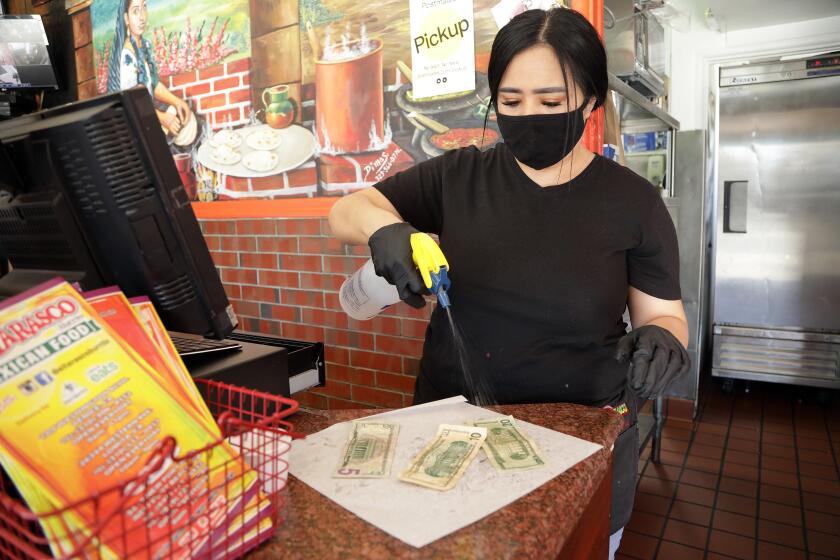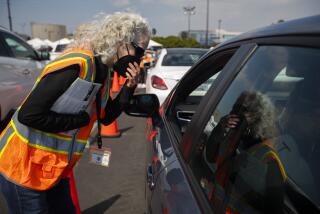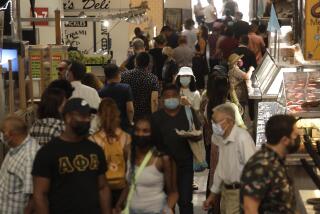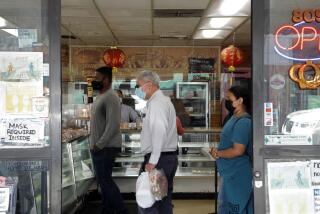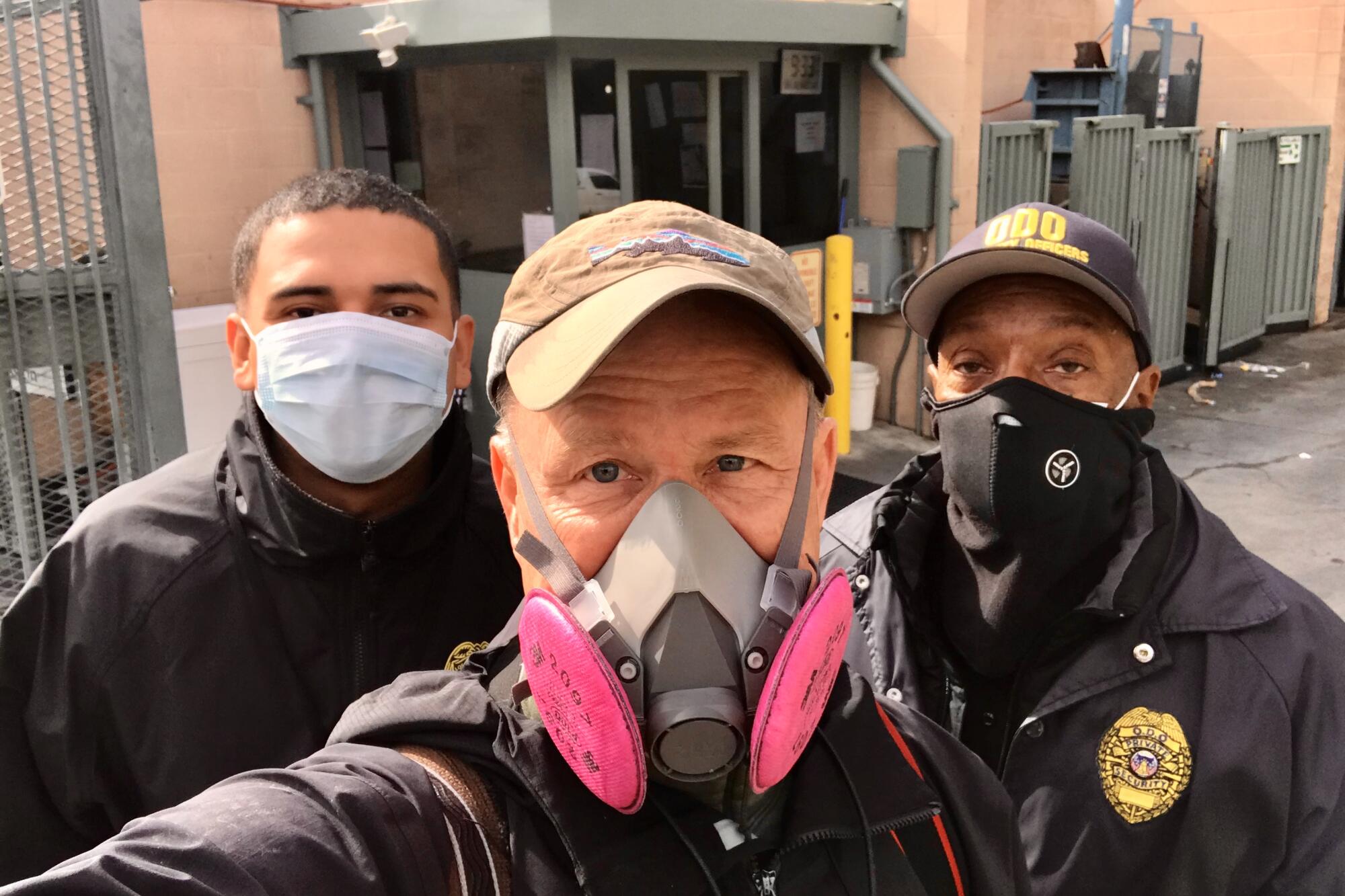
- Share via
Through 36 years at the Los Angeles Times, I’ve covered earthquakes, riots, fires, mass shootings and conflict in foreign nations, but the coronavirus is different.
I’ve documented the pandemic from Los Angeles International Airport to Union Station, and from the crowded Los Angeles Produce Market to crowds vying for access to grocery stores. I have photographed empty beaches to boarded-up stores in Beverly Hills. I’ve documented the nation’s second-largest school district scramble to reinvent education and feed students with knowledge and food. I have feared for my safety from a microscopic enemy that will cling to everything you wear or the camera equipment you use, from the soles of your shoes to the face mask you pray won’t fail in the process of taking photographs in the emergency rooms at UCLA or on the streets of skid row. But what makes this event different from others in my years as a photojournalist is that it threatens my family.
Every member of my family is a frontline responder. My eldest son is a firefighter/engineer/medic running on COVID-19 patient calls every night of his shift, and has to decontaminate after every run. My daughter-in-law, his wife, is a physician assistant in the emergency room of a regional hospital on the overnight shift receiving COVID-19 patients and making life-and-death decisions. My other son is a medical speech pathologist working at a hospital helping and comforting seniors and head-injury patients whose health is already compromised. They are scared. My wife is also a speech pathologist working with at-risk seniors in skilled nursing facilities that have become the epicenter of the coronavirus pandemic’s deadly strike.
We are an entire family fighting this crisis in a variety of ways. Together we share stories of our daily experiences: patients we have seen, tragedies we have witnessed. The conversation turns to which personal protective equipment works best, how to effectively sanitize our clothing, and the safest rotation of face masks we must reuse. My daughter-in-law’s mother sews colorful custom masks for every member of the emergency room to wear for protection and to cheer them up.
These are the photos and stories of the Los Angeles Times photojournalists covering the pandemic:
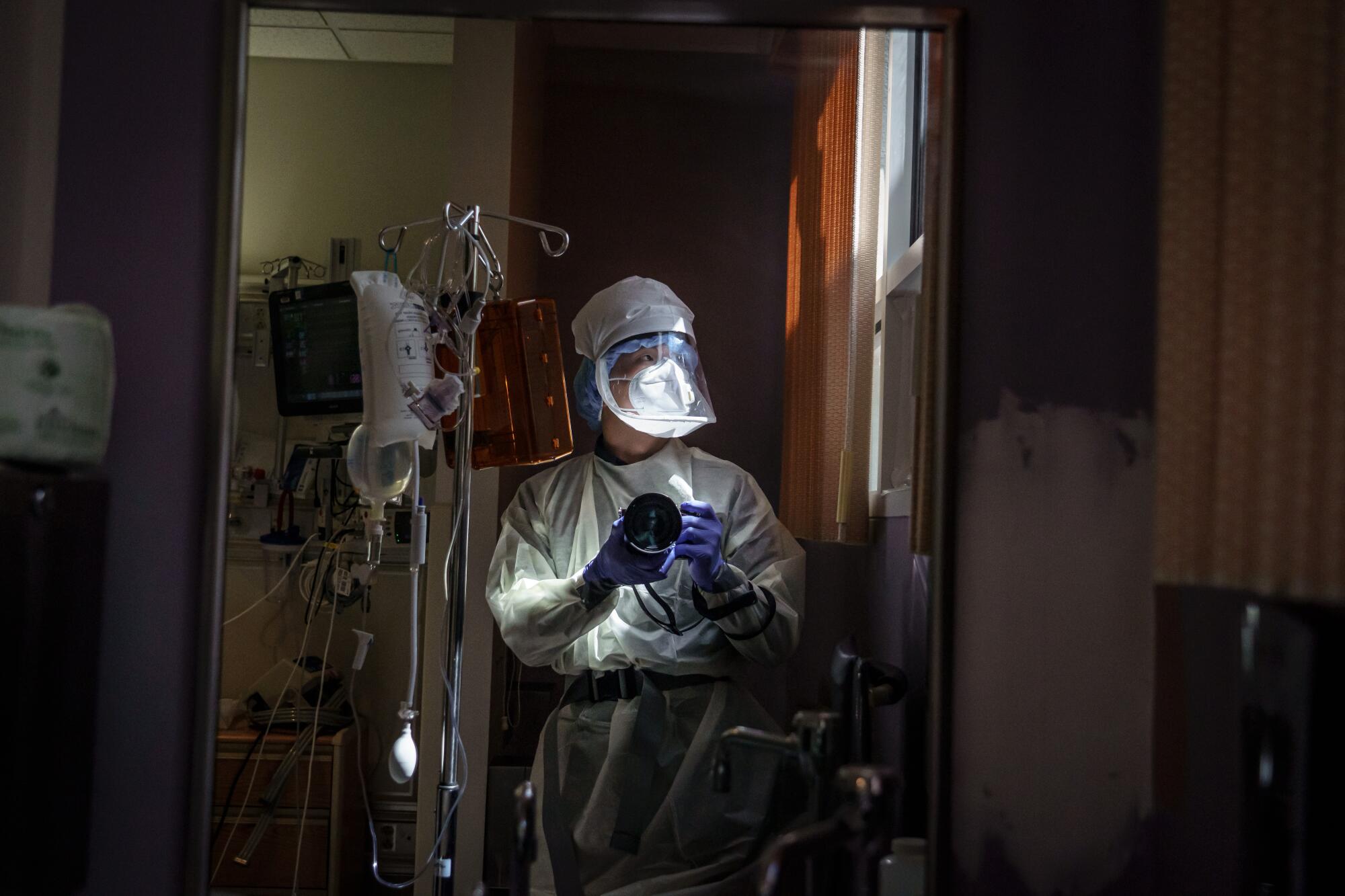
MARCUS YAM
When I first saw myself in the mirror, I thought it was someone else looking through a window into the negative pressure isolation room I was in. I did not recognize myself in the personal protective equipment and full-face powered air-purifying respirator I was wearing. I was there to document healthcare workers inside the intensive care unit at Scripps Mercy Hospital Chula Vista, and a COVID-19 patient had just arrived from the emergency room and needed to be intubated to save her life.
As a photojournalist, I’ve made a life out of navigating the unknown. But this pandemic is unpredictable and nebulous and has challenged my personal equilibrium. Air travel now comes with a risk, global economies are crumbling and everyone is forced to isolate and distance themselves from almost everything and everyone they know. As a publication, we have always been outward looking, but COVID-19 has pushed us into a period of self-reflection, and we now have to look deeper inward. News photographers don’t have much choice of whether to work in isolation from our homes. Our jobs thrust us into the field, often in harm’s way, but it’s imperative for us to be the eyes and ears for our readers and our community as we navigate this crisis.

GINA FERAZZI
I have been covering the coronavirus pandemic for more than a month now, from documenting the virus’ effect on the Navajo Nation in rural Arizona to my own neighborhood in Southern California.
On this day, April 8, I am wearing an N95 mask and nitrile gloves while standing across the street with a Canon 200-400mm lens. My assignment is to document the evacuation of more than 80 patients at a nursing home in Riverside after 34 tested positive for COVID-19 and the nursing staff stopped showing up for work.
All the patients were being moved to other facilities. Prior to transmitting photos from my laptop in the car, I dispose of the gloves, wipe down my camera gear with disinfectant wipes, spray my shoes with disinfectant, remove my N95 and place it on my dash and clean my hands with sanitizer.
I repeat these steps after shooting each time. When I get home at the end of the day, all my clothes go into a plastic bag and into the laundry. My shoes stay outside. And then I shower. These are the necessary precautions all photojournalists are taking to stay safe.
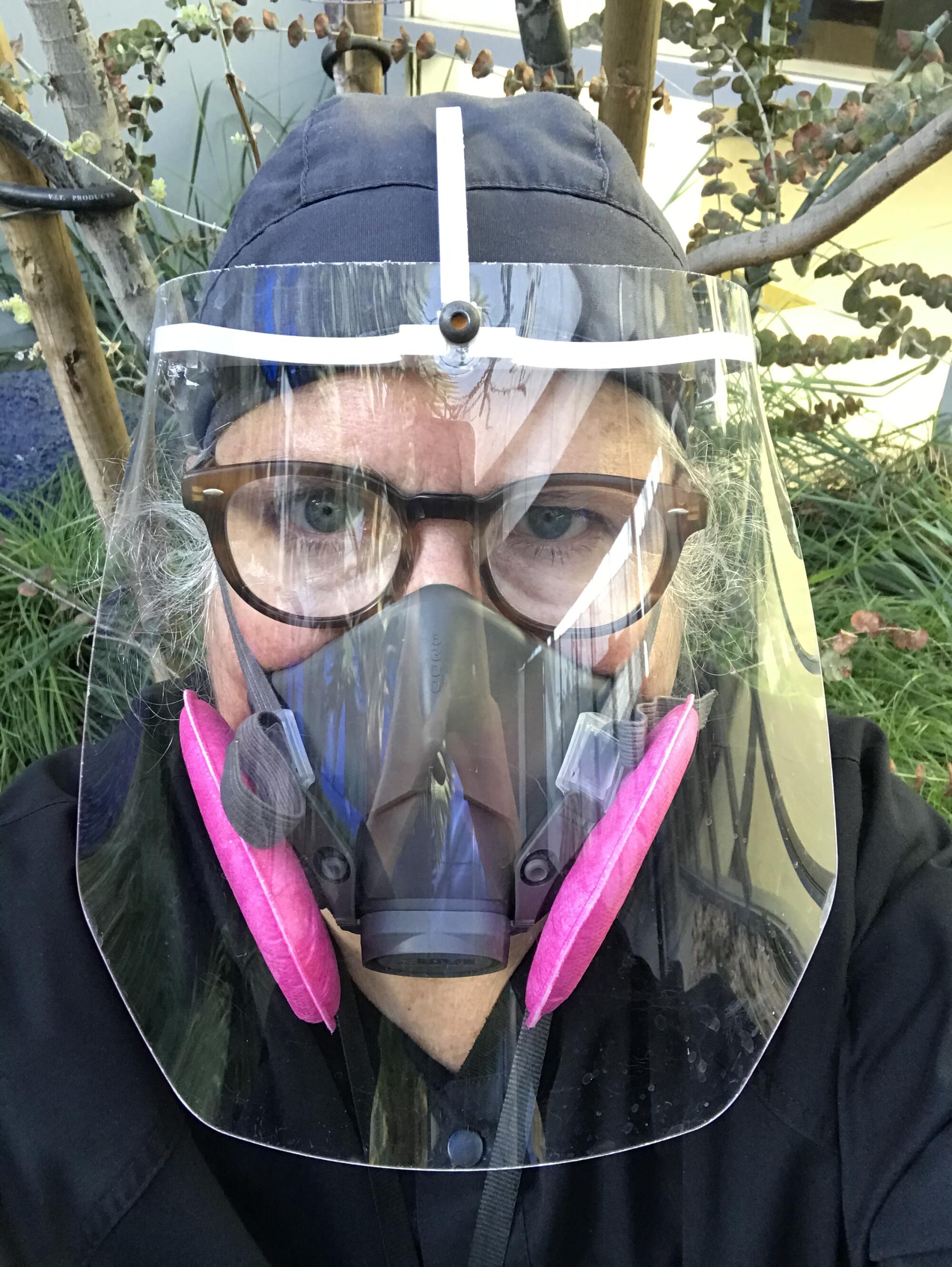
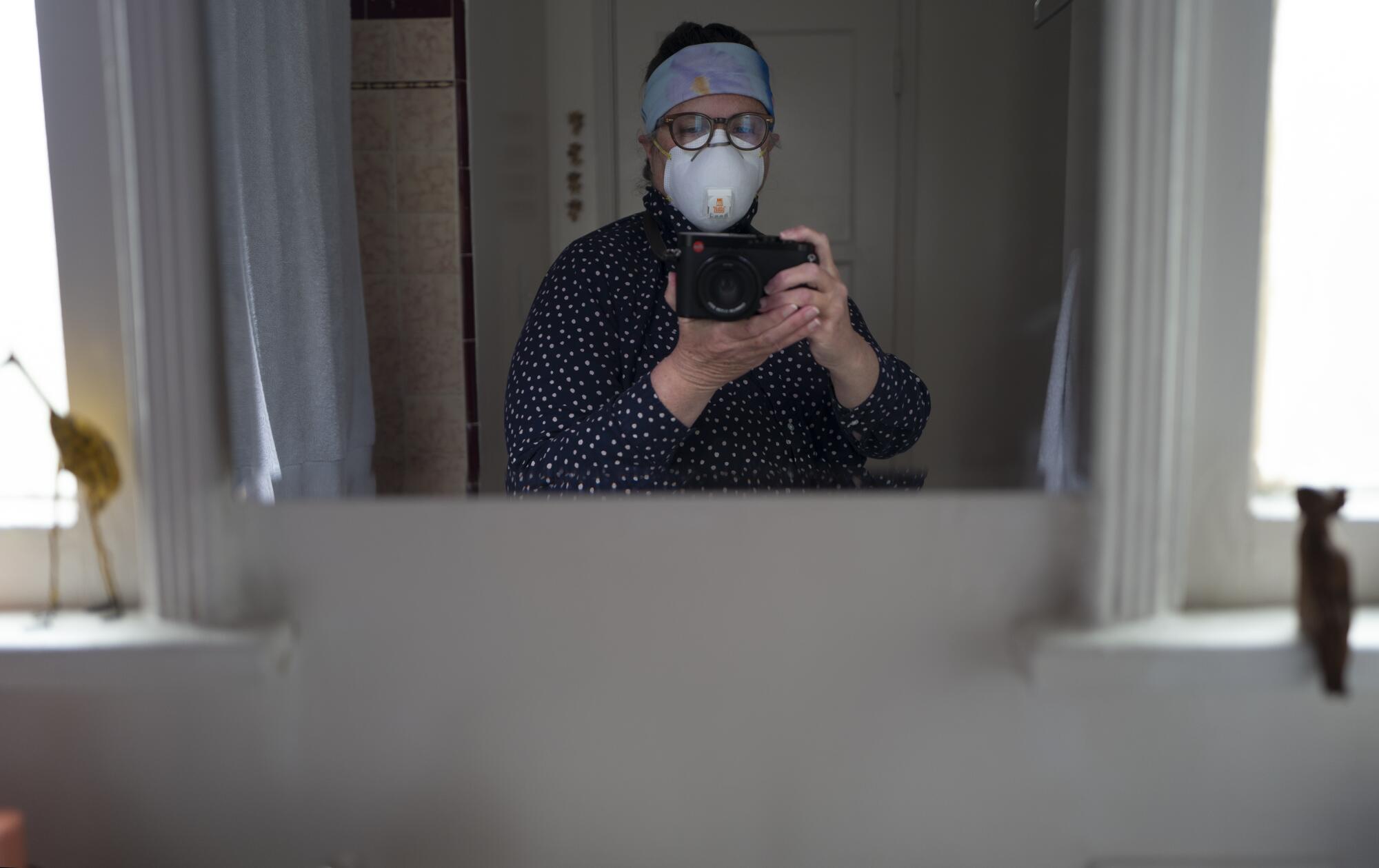
FRANCINE ORR:
In the top selfie, I prepared to cover an assignment inside a local hospital with coronavirus patients.
The lower selfie, I was getting ready to cover two assignments, including a Passover Seder through a window.
I have switched to pulling my hair back and covering it. I have a multi-step cleaning process, which includes a bar of soap and water. I was a Peace Corps volunteer, and I always have a bar of Dial soap with me.
I was out of town on assignment when the coronavirus story broke. I bought gloves, a bar of soap and a thermometer, because I knew by the time I got home a thermometer would be hard to find.
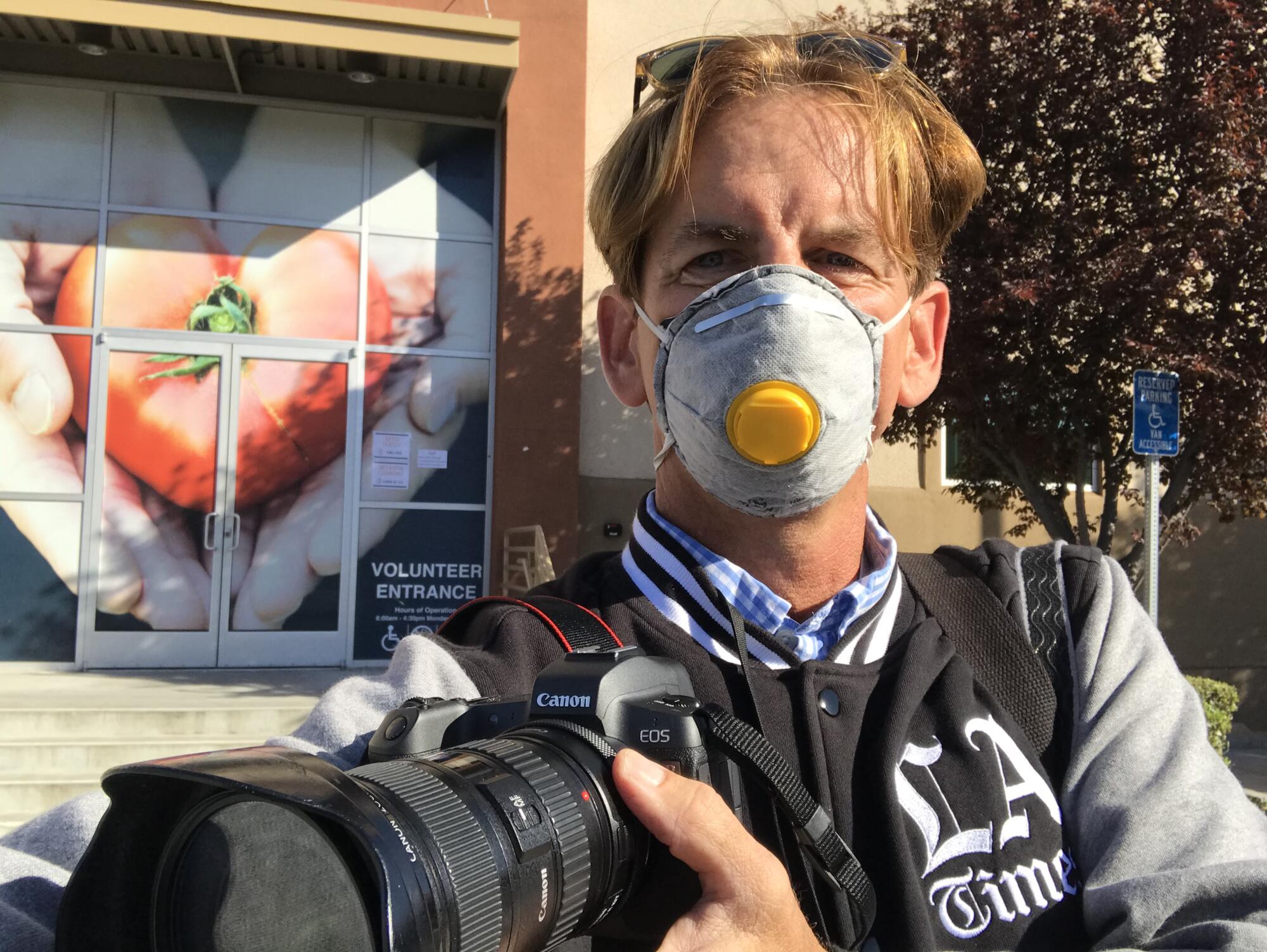
ALLEN J. SCHABEN
As I begin my 27th year as a member of the Los Angeles Times photo staff, I find myself working in unprecedented times and conditions. However, photographing Southern California’s dynamic news scene requires that I live by the Boy Scout motto: Be prepared.
Covering major news events like fires, floods, protests and crime scenes has kept us on our toes and taught us to always be prepared for just about anything. We keep protective gear in our cars at all times. The coronavirus pandemic has added a tremendous amount of risk. One slip-up in our routine could prove deadly to ourselves, our families or others.
My approach is to not touch anything I don’t have to. I wear gloves, a mask, hat, sunglasses and keep my distance from people. I mostly use long lenses, which helps puts distance between me and subjects. I constantly wash my hands with soap and water, use sanitizer, wipe down camera equipment and car, and change out of my clothes in the garage.
Our family got a new puppy, which has been an absolute joy during these difficult times. To stave off depression, I take walks and bike rides with my wife and puppy, hang out with my teens as much as they will allow, listen to music, pray a lot and rely on my faith in God to get through this.
I am thankful to all of our subjects for taking time to tell their important stories and to all the first responders; grocery, food service workers; and all the other vital/essential workers who help us all survive.
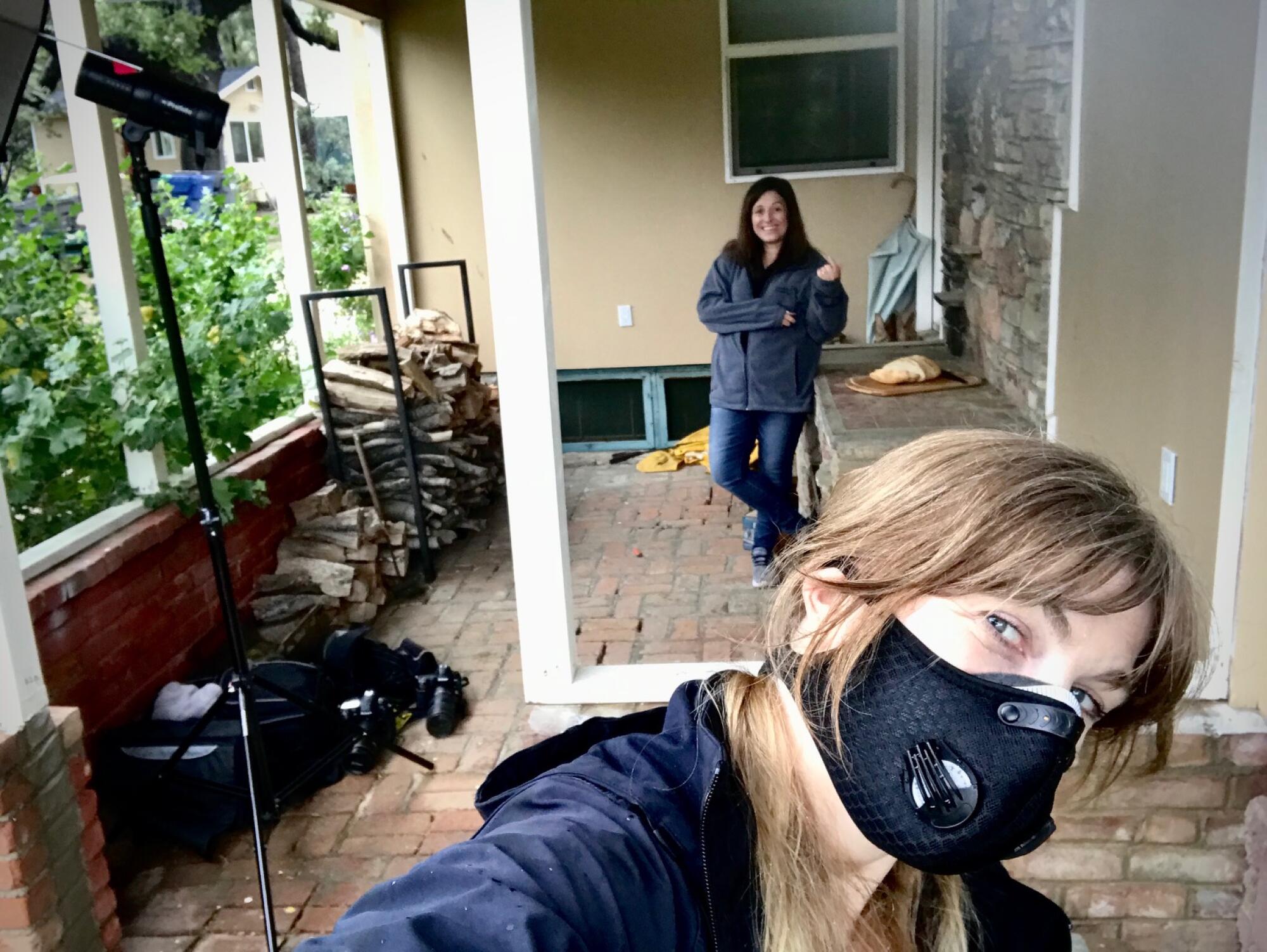
MARIAH TAUGER
A portrait shoot on a day rainy day in Santa Clarita at the home of casting director Sharon Lieblein.
She told me she had learned to bake her own bread during the stay-at-home order. Allowing for social distancing to keep us both safe, we did the shoot outdoors on a covered porch, which had the added bonus of keeping Sharon dry!
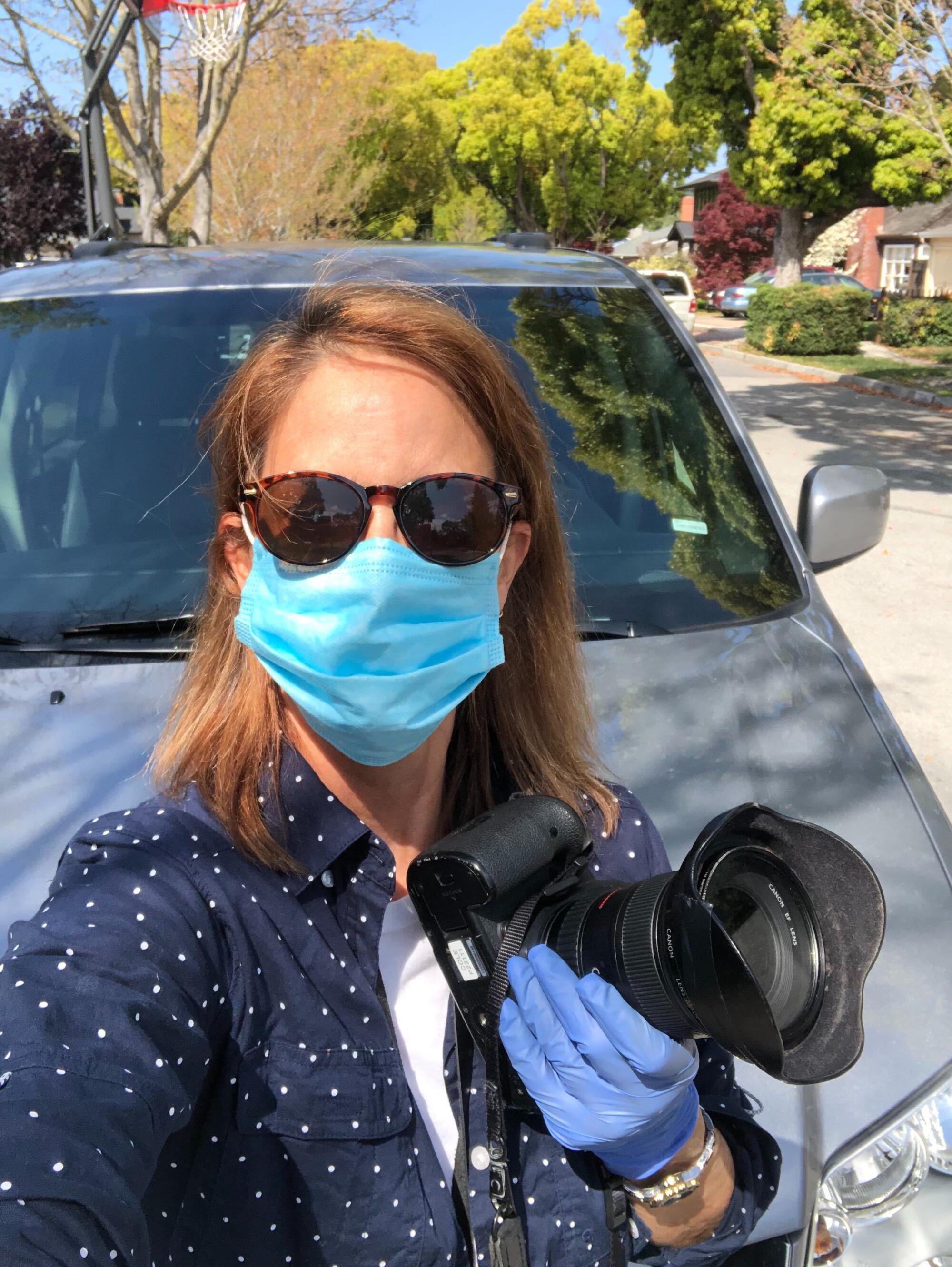
CAROLYN COLE
Over the last 30 years, I’ve covered natural and man-made disasters, including Hurricane Katrina, the Haiti earthquake, and the Iraq and Afghanistan wars, but the COVID-19 pandemic is of an even larger scale, affecting millions of people.
My focus is on covering rural California and how the coronavirus has changed lives in less populated places, such as Madera, Eureka and Crescent City.
I’m also interested in nature and how the shutdown has changed the balance between humans and the natural world. The coronavirus has caused immense human suffering, but hopefully the lessons learned will reshape our priorities as we move forward.
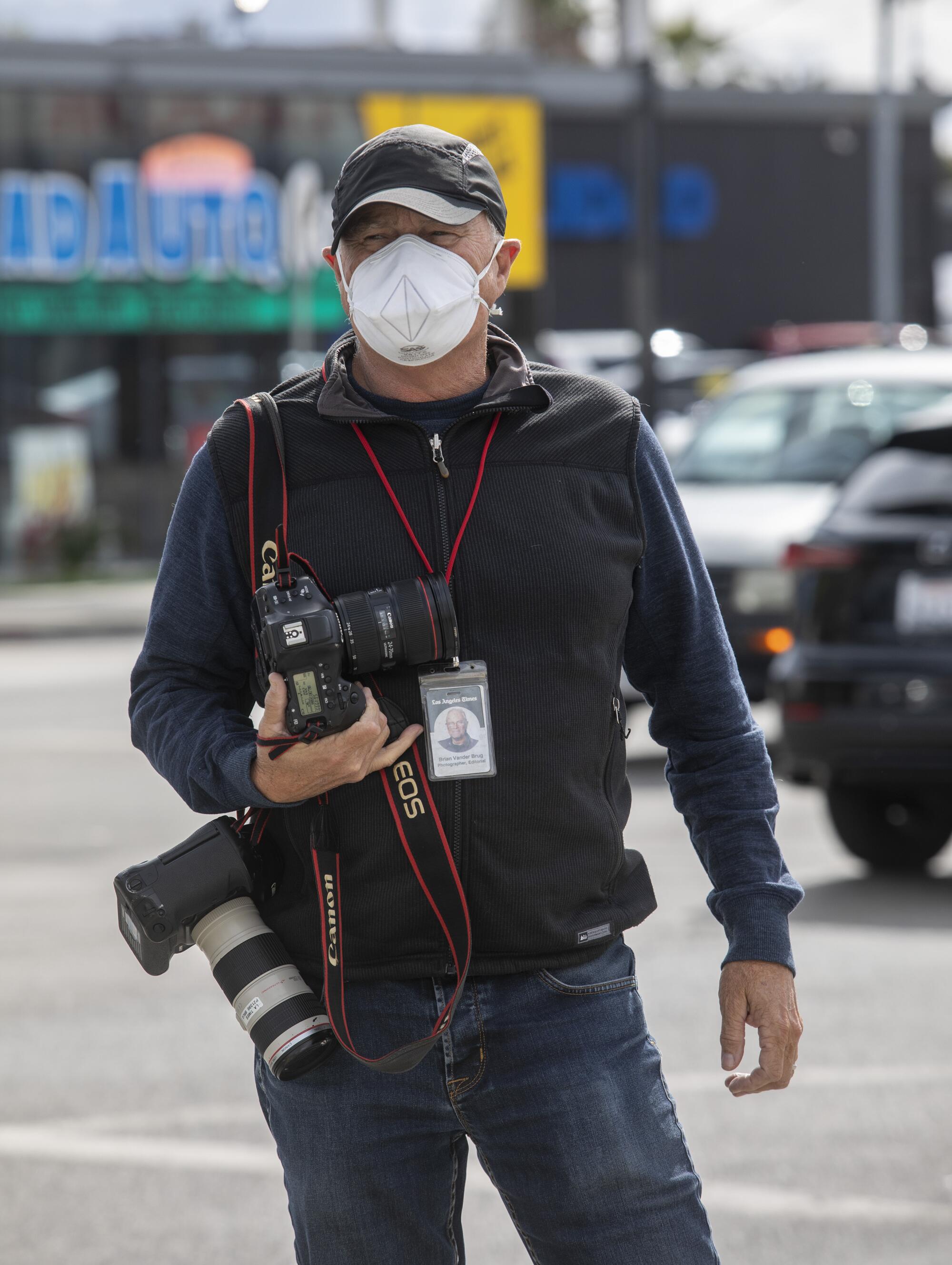
BRIAN VAN DER BRUG
While many people are riding out the coronavirus epidemic at home, many must go out and work. I’m in that group.
As photojournalists, we often need to get close to people to capture images. For their safety and ours during the crisis, we’ve changed the way we work, the way we compose images and interact with people.
Documenting life with the coronavirus means greeting subjects from behind a mask at a distance and taking pictures with longer lenses. It means coming home and disinfecting anything that may have come in contact with the virus, on our clothes or on our equipment.
Our editors tell us often that we can decline to cover something if we don’t want to, but it’s our job to be there for our readers, and one I’m committed to doing.
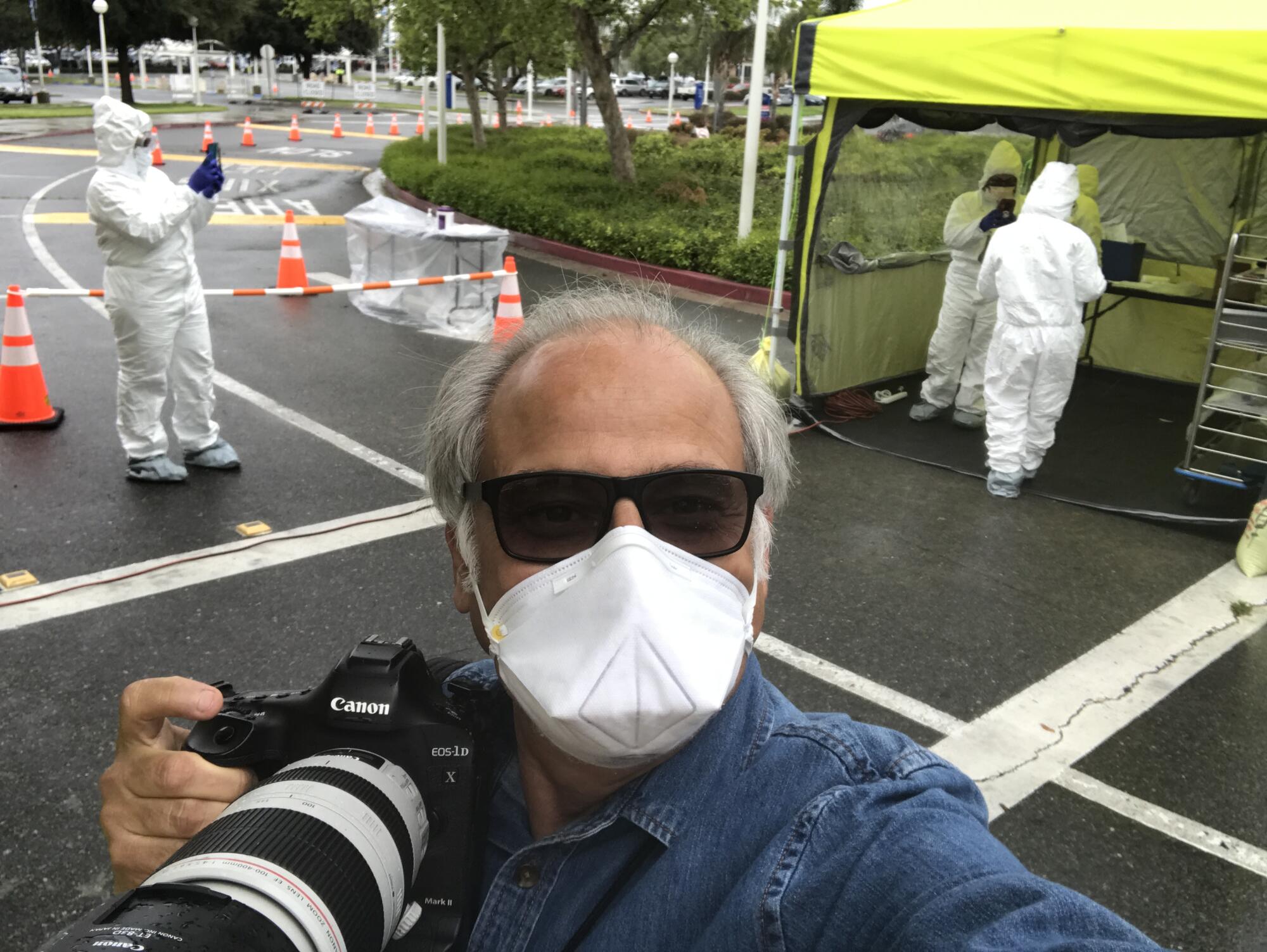
IRFAN KHAN
The coronavirus pandemic has surely affected my work life. Every morning, I leave for work with a hope and prayer to not contract the virus. My “normal” mornings used to involve ensuring that my cameras were working and batteries were charged. My new normal has the added task of confirming that I have proper protective equipment like face masks, sanitizing wipes and gloves.
This morning, I photographed a drive-through coronavirus testing site at Arrowhead Regional Medical Center in Colton. Abiding by safety guidelines, I wore a face mask and stayed at a distance to decrease my exposure and acknowledge patient privacy. As typical for my photography during the pandemic, I used a long lens.
After completing my assignment, I used sanitizing wipes to clean my cameras, cellphone and portions of my car. While this has proved to be a unique and unsettling experience for all, I am glad I have the opportunity to continue to capture the current reality through the lens of my camera.
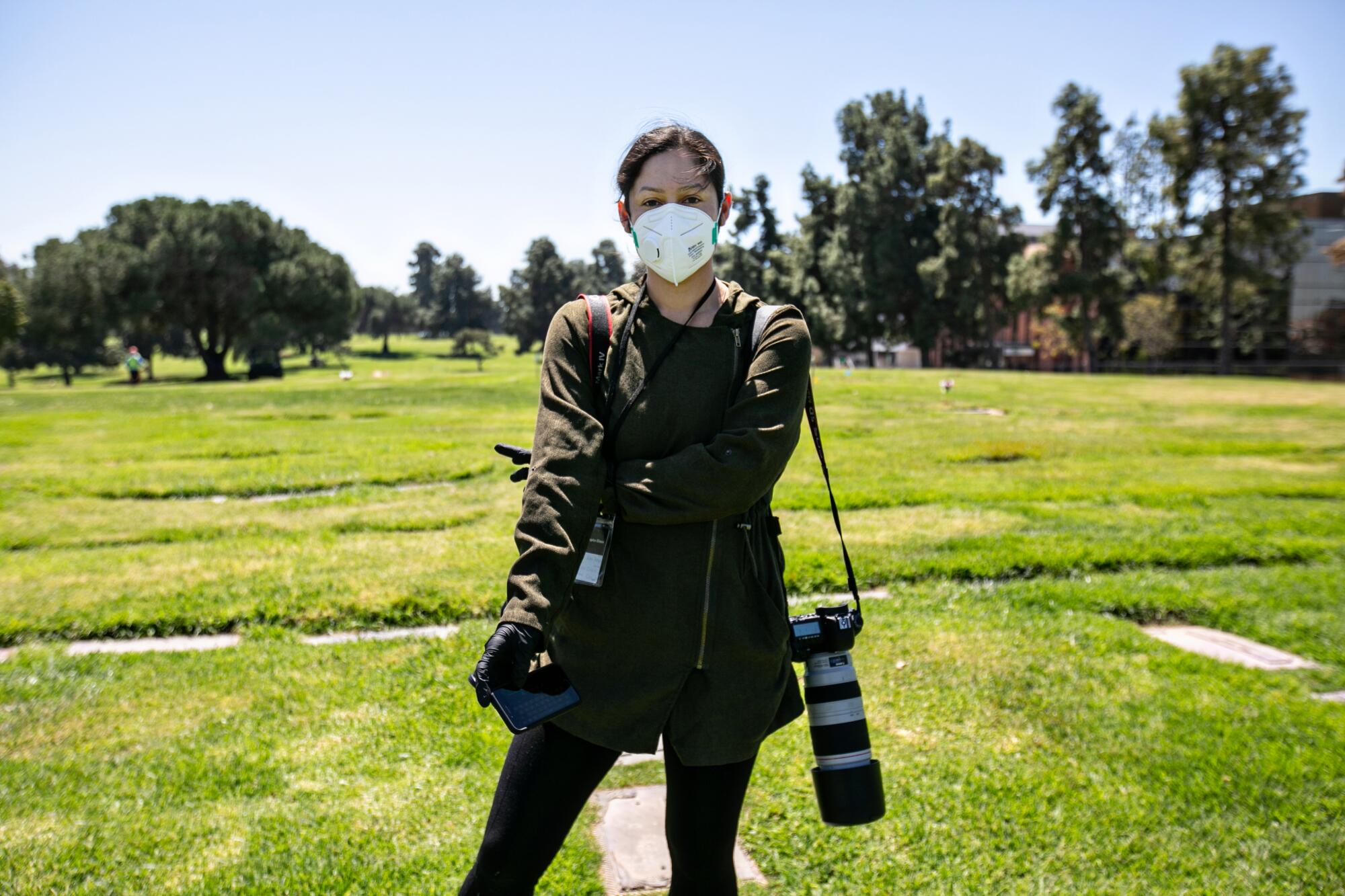
CHRISTINA HOUSE
This is me covering a funeral for a man who died of COVID-19. The service was held indoors for a small group of 10 people. I felt the need to wear my heavier-duty mask after consulting with my fellow photographers at The Times. They suggested it would keep me safest in an enclosed environment.
The story was about a family dealing with the terrible loss of a loved one to the novel coronavirus and what restrictions and safety measures they had to take while grieving their loss. It was an important story to tell our readers because it humanized the pandemic and put a face on the numbers that we all have been hearing every day, with increasing regularity.
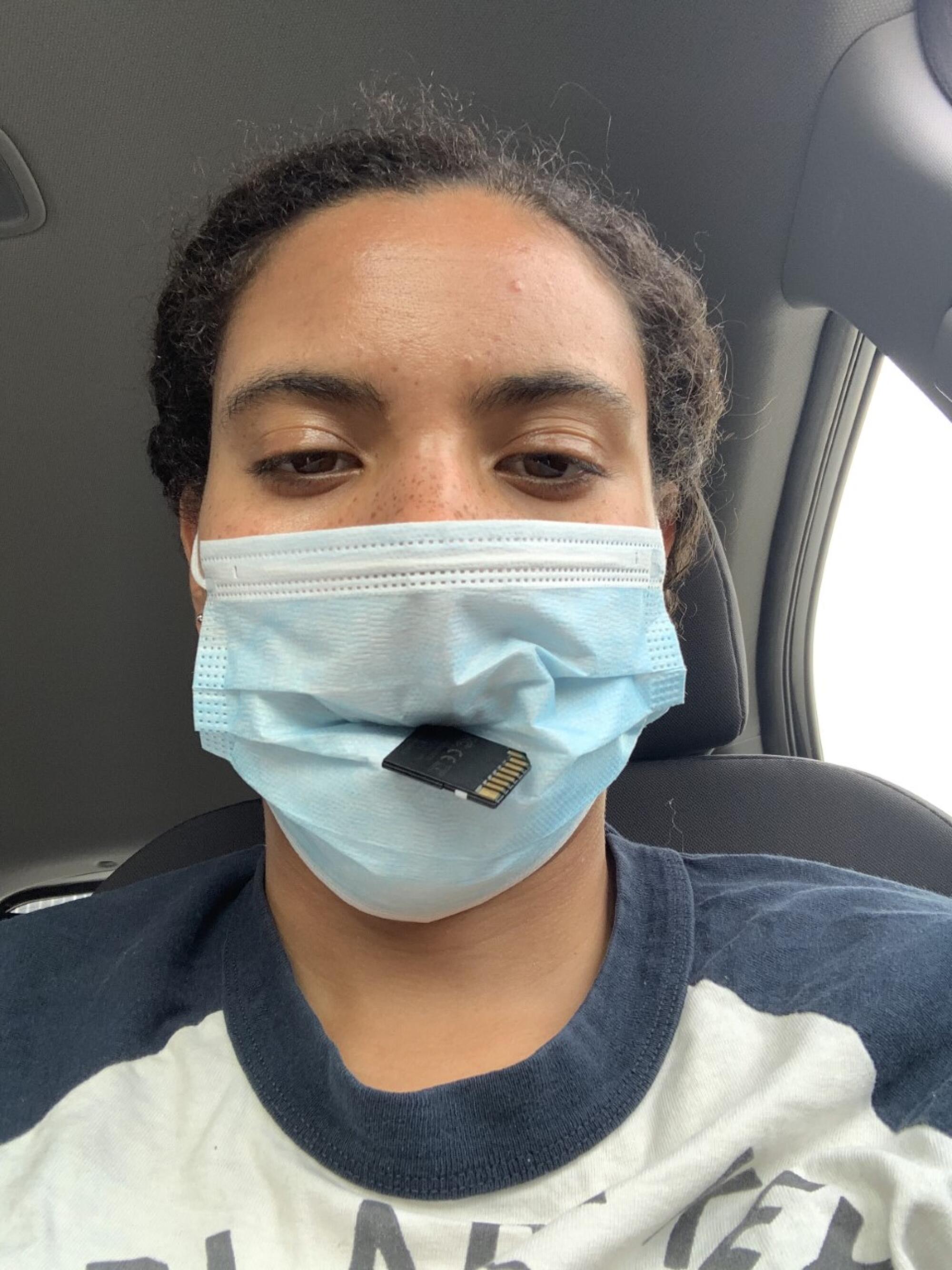
GABRIELLA ANGOTTI-JONES
I’m finding that most of my images are fueled by anger.
Meanwhile, people are scared. And dying. I’m doing what I can by sanitizing myself every time I go out on assignment and come back to my car (which is exhausting), but I know that by continuously being outside, I’ll eventually become sick or exposed. I worry about passing the virus to other people, even if I’m taking the proper precautions.
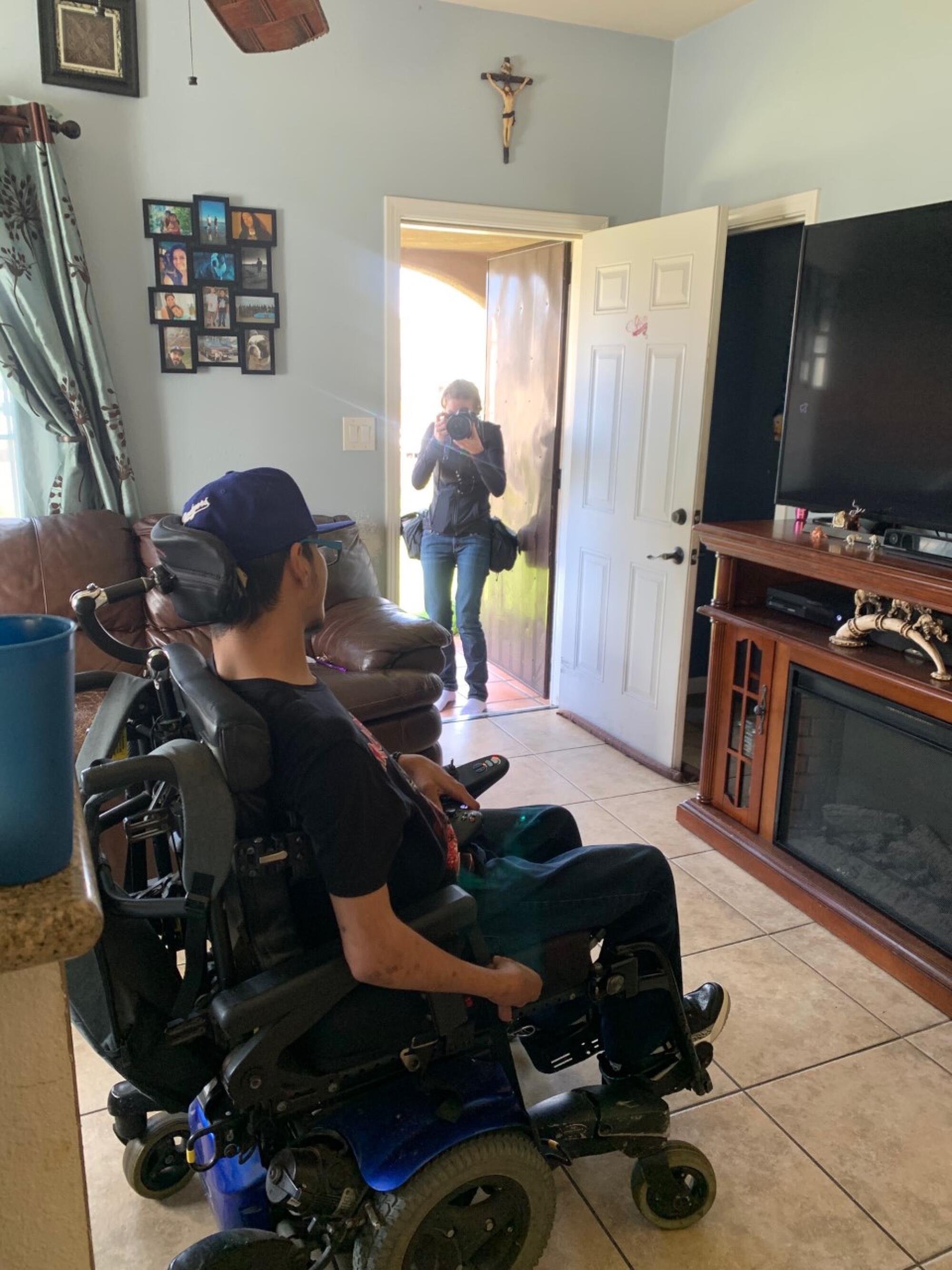
DANIA MAXWELL
Evelyn Peña, a South L.A. parent and president of the nonprofit Deaf Latinos y Familias, provided this picture of me photographing her son Darlin in their house.
The story was about how families are having to cope with inadequate resources for their special-needs children at home from school during the coronavirus outbreak. I took the photo standing from their front door, with a mask on and with my shoes removed.
I felt it was important for me not to go into their home because Darlin is immunocompromised. We, as photographers, need to ensure we aren’t putting people at greater risk when they are a part of our coverage.
GENARO MOLINA
I am standing with members of the Love My Neighbor Foundation after documenting their efforts to feed the homeless in downtown L.A.’s skid row during the novel coronavirus pandemic.
There are so many heroic efforts happening in these precarious times, and I was happy to photograph the Love My Neighbor Foundation helping this vulnerable population. At a moment when community matters more than ever, these brave souls perfectly illustrate the courage and commitment of our concerned citizens.
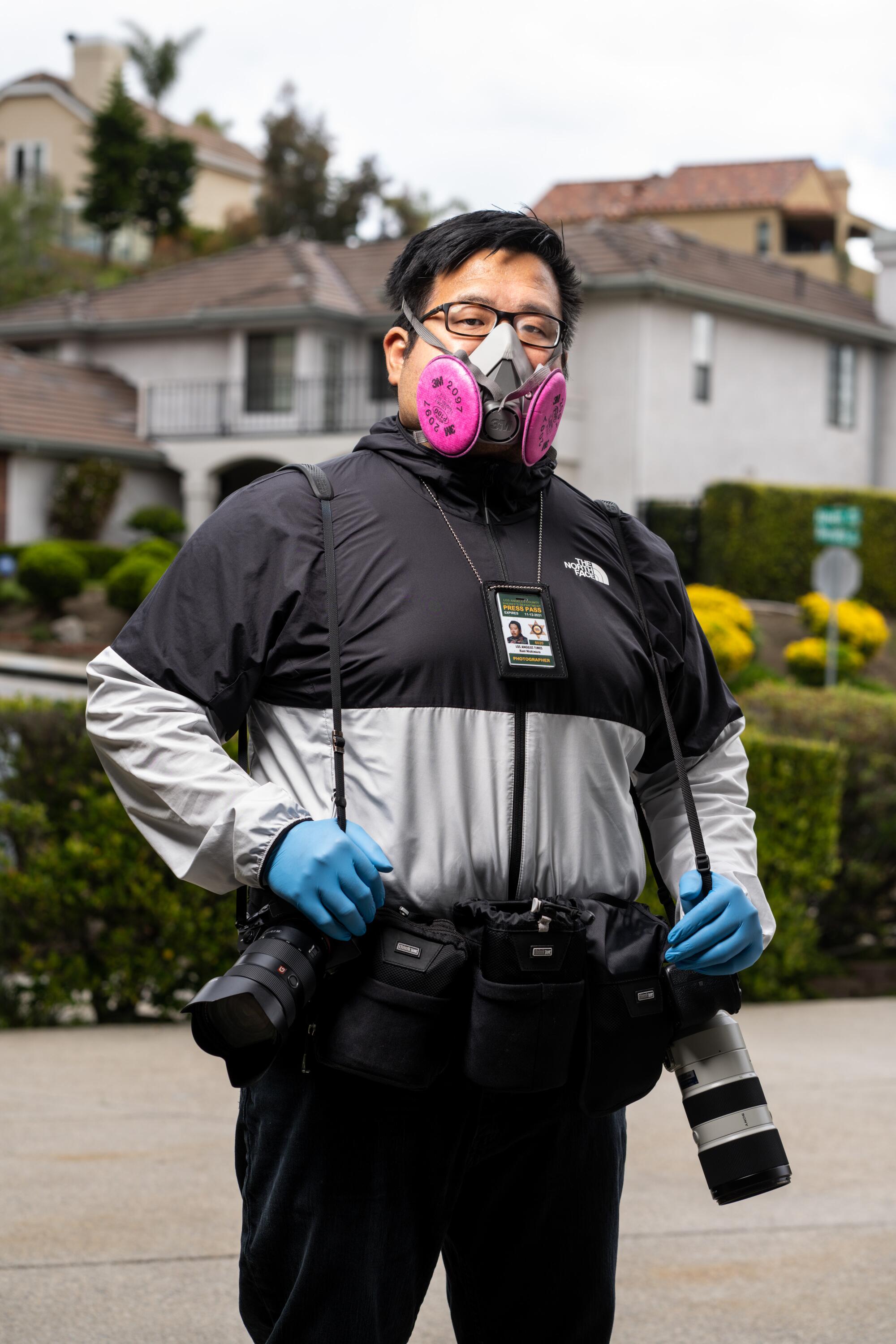
KENT NISHIMURA
Our staff of photographers is out in the field every day photographing the coronavirus pandemic’s impact on Los Angeles, California and the world. But being out and about in a time of social distancing and isolation can pose challenges for us.
For me, that includes keeping myself safe when I return home from assignments. Using an assortment of sanitizing wipes, I’ll clean my hands, my cameras, my keys, my backpack, my wallet and the interior of the car to make sure everything that has been exposed or handled outside has been sanitized.
I’ll also wipe down my shoes with a towel and a diluted bleach solution, and I’ll store them separately from my other footwear. On entering the house, I’ll immediately remove my jacket and place it in a separate laundry bag for clothes that have been used outside that day and immediately go to my shower, then toss the clothes into the wash. Every door knob and surface I touched on the way into the house will be wiped down and sanitized with an alcohol solution.
When I’m out on assignment, some of the items that I carry with me, in addition to my cameras, are a 6000 series respirator with N100 filters, N95 masks, nitrile gloves, safety goggles and, of course, toilet paper. You never know when you’ll need it. That stuff is gold. You could barter with it.
JASON ARMOND
My approach to assignments has changed because of the coronavirus pandemic. Before I even leave my apartment each morning, I suit up in personal protective equipment. I begin my day asking myself, “How do I safely move from my apartment to my car, from my car to my assignment, and return home safely?”
Normally on assignments I tend to spend a lot of time just waiting for moments to unfold. This common practice has changed somewhat for me. My colleague, fellow Times photographer Francine Orr, recently shared with me a great tip. She said that her mantra for assignments during corona is to get in, get out and be safe. I now repeat this mantra several times throughout my day.
I feel I have a duty to protect my health and the health of the people whose stories I’m telling.
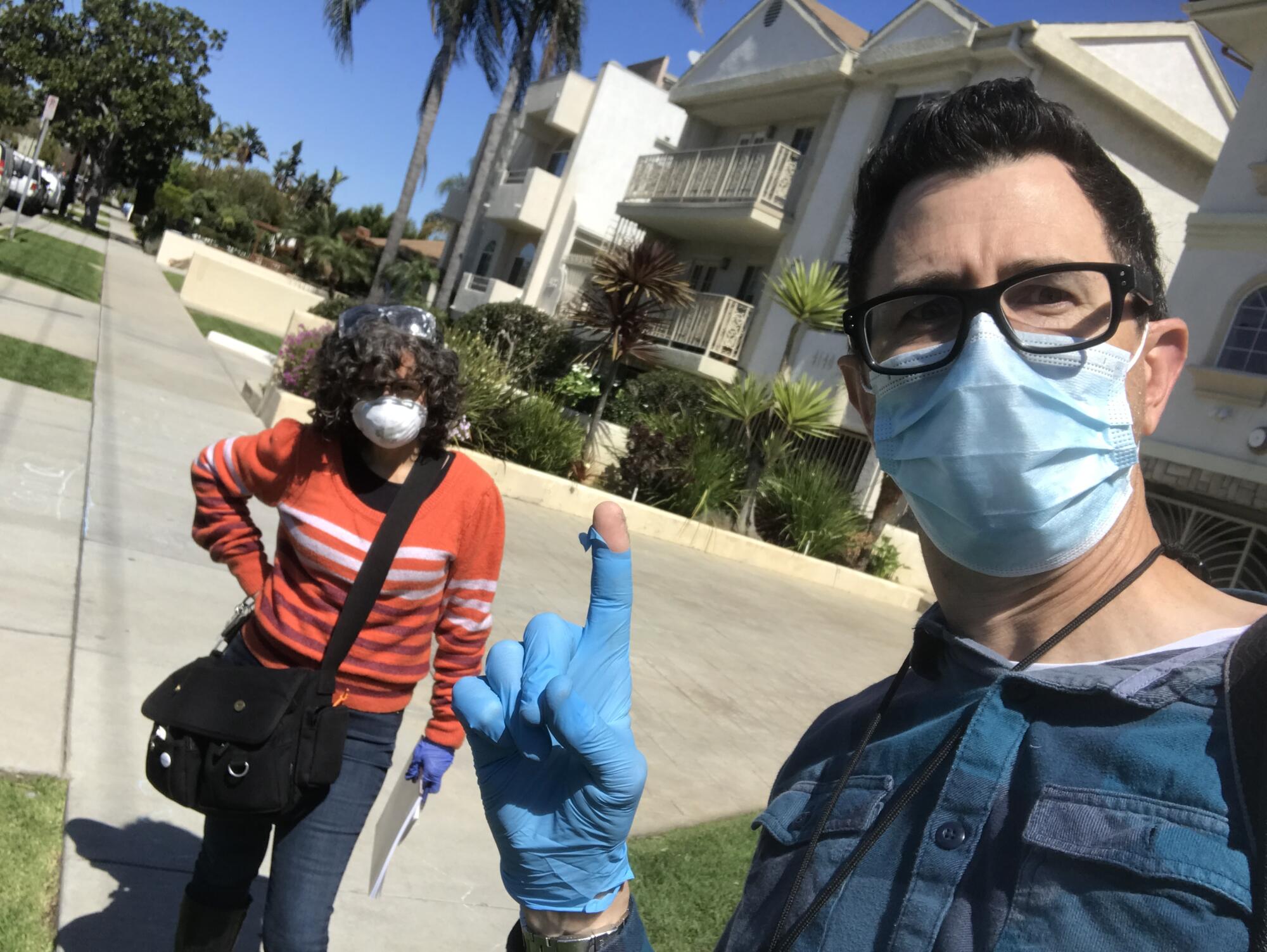
JAY L. CLENDENIN
Me and L.A. Times arts and culture writer Carolina Miranda. We checked in with five L.A. artists (from a distance) to record the ways in which they have continued to work, in a portfolio of portraits. Wearing gloves and masks, I stuck to one strobe on a stand, moving it into position and then asking the subject to step in.
After each shoot, I was wiping all my equipment down with alcohol swabs and stripping down in the garage, before heading straight to shower!
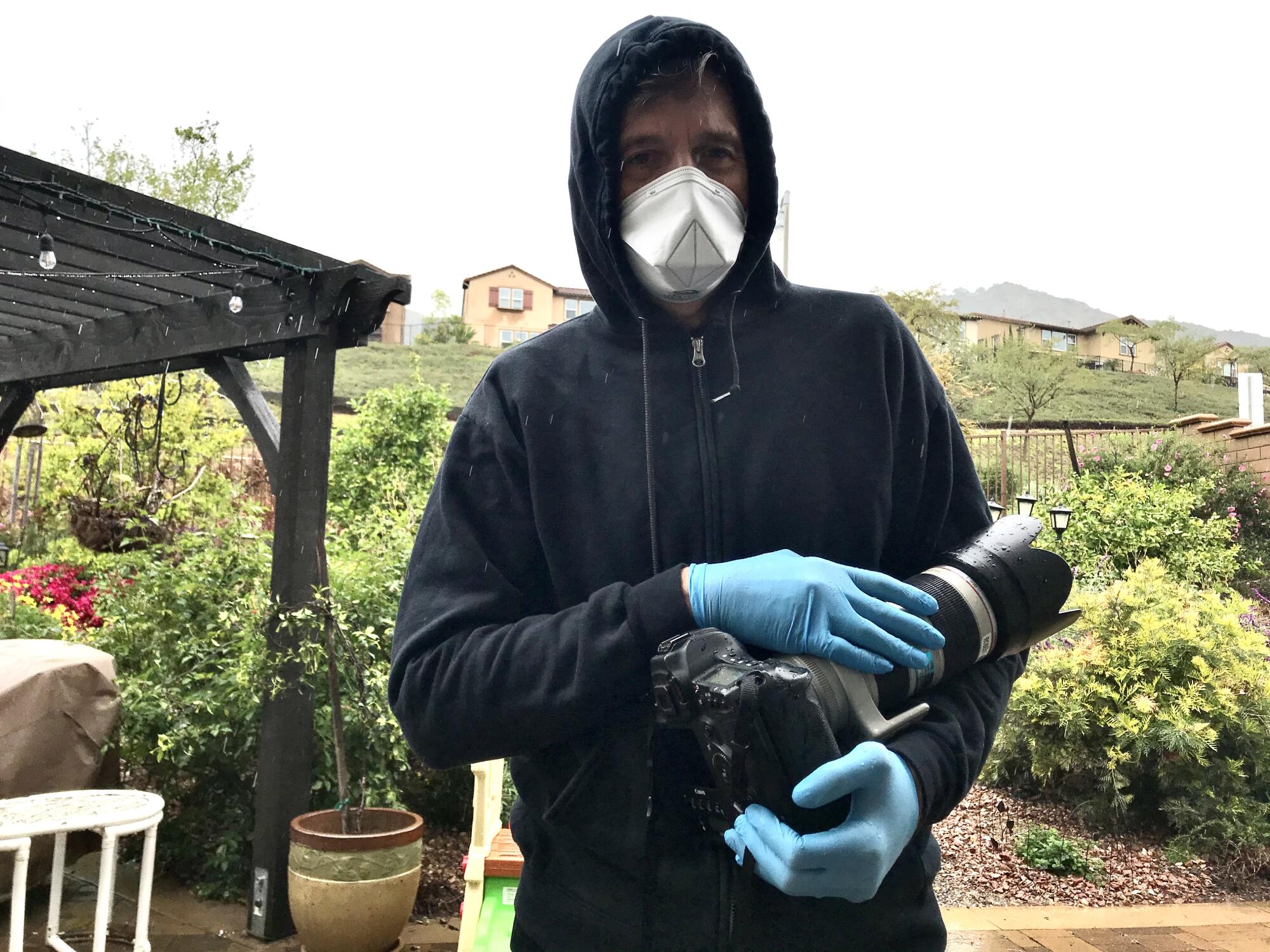
ROBERT GAUTHIER
I’ve been looking for images that reflect the complexities of living in the time of COVID-19. One such image showed teenagers, masked and gloved, playing basketball in a public park that had been closed for nearly a week. They were locked arm in arm on the court, wrestling for the ball. I thought it should alarm people to see such disregard and lack of real understanding of the virus and its virulent nature.
Apparently, the city took notice and cut the baskets’ nets the day the photo was published.
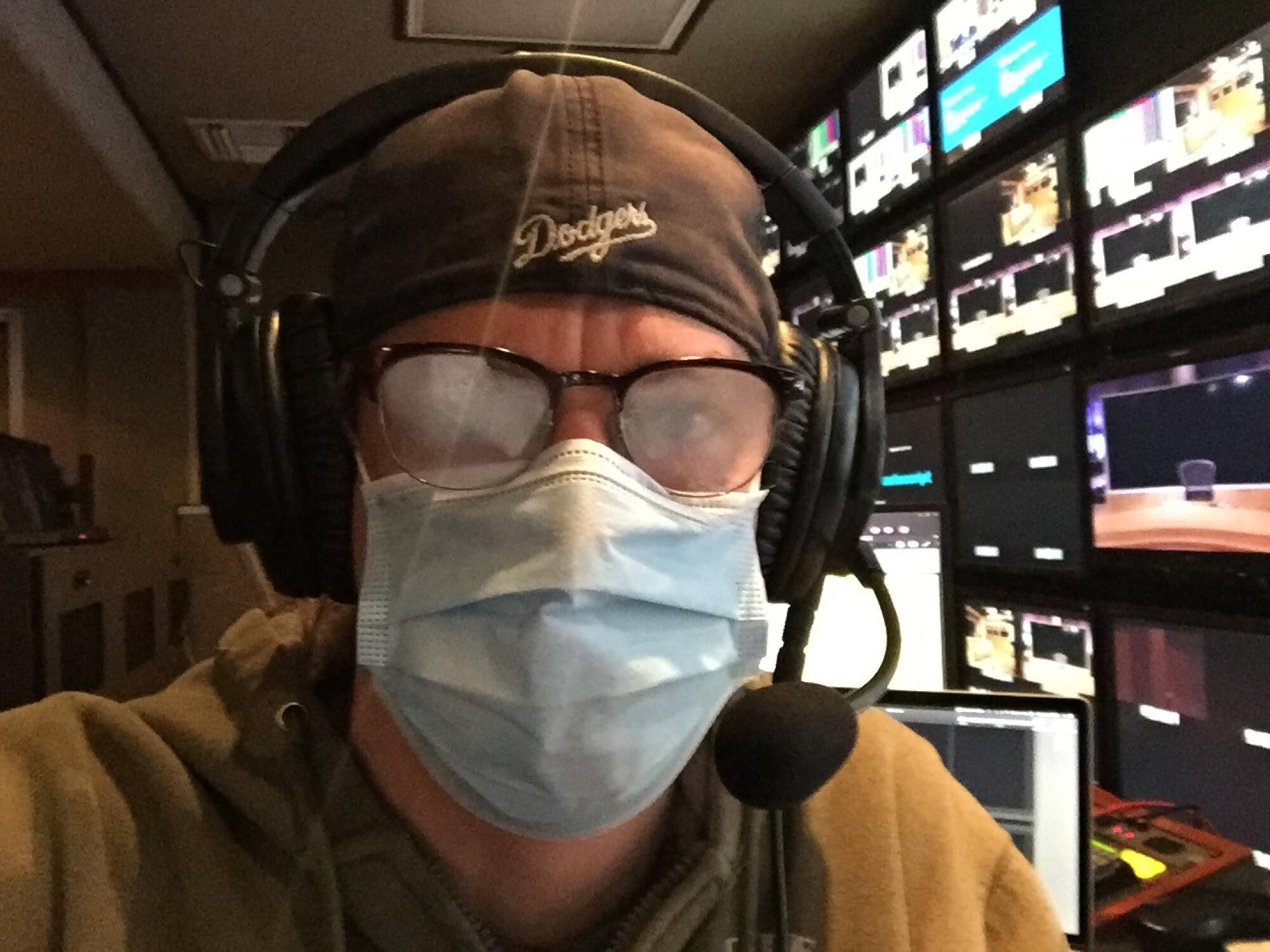
JEFF AMLOTTE
I’m now required to wear a mask at work, which I am completely OK with, while directing the “L.A. Times Today” show on Spectrum News 1. However, I don’t think these masks (or any masks, for that matter) were designed for people wearing glasses. Because with each breath I take, the foggier my vision becomes.
MYUNG CHUN
I photographed a story about the homeless and residents of downtown L.A.’s skid row receiving meals and masks. Afterward, I went through the steps to disinfect my camera gear and myself, including the bottom of my shoes, and then began editing and transmitting pictures from my laptop in my car.
The biggest challenge working during this time is trying to maintain social distance. Not everyone wears masks or understands the need to keep some distance
These are some of the unusual new scenes across the Southland during the coronavirus outbreak.
Los Angeles Times’ visual coverage of the coronavirus crisis
More to Read
Sign up for Essential California
The most important California stories and recommendations in your inbox every morning.
You may occasionally receive promotional content from the Los Angeles Times.

